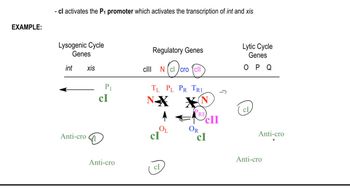Table of contents
- 1. Introduction to Genetics51m
- 2. Mendel's Laws of Inheritance3h 37m
- 3. Extensions to Mendelian Inheritance2h 41m
- 4. Genetic Mapping and Linkage2h 28m
- 5. Genetics of Bacteria and Viruses1h 21m
- 6. Chromosomal Variation1h 48m
- 7. DNA and Chromosome Structure56m
- 8. DNA Replication1h 10m
- 9. Mitosis and Meiosis1h 34m
- 10. Transcription1h 0m
- 11. Translation58m
- 12. Gene Regulation in Prokaryotes1h 19m
- 13. Gene Regulation in Eukaryotes44m
- 14. Genetic Control of Development44m
- 15. Genomes and Genomics1h 50m
- 16. Transposable Elements47m
- 17. Mutation, Repair, and Recombination1h 6m
- 18. Molecular Genetic Tools19m
- 19. Cancer Genetics29m
- 20. Quantitative Genetics1h 26m
- 21. Population Genetics50m
- 22. Evolutionary Genetics29m
12. Gene Regulation in Prokaryotes
Lambda Bacteriophage and Life Cycle Regulation
Problem 28c
Textbook Question
How would mutations that inactivate each of the following genes affect the determination of the lytic or lysogenic life cycle in mutated λ phage strains? Explain your answers. int
 Verified step by step guidance
Verified step by step guidance1
Understand the role of the 'int' gene in the λ phage life cycle. The 'int' gene encodes the integrase enzyme, which is crucial for integrating the phage DNA into the host genome, a key step in establishing the lysogenic cycle.
Consider the effect of an inactivated 'int' gene. Without a functional integrase enzyme, the phage cannot integrate its DNA into the host genome, which means it cannot enter the lysogenic cycle.
Recognize that if the lysogenic cycle is not possible, the phage is more likely to default to the lytic cycle, where it replicates and eventually lyses the host cell.
Reflect on the broader implications: the inability to enter the lysogenic cycle could affect the phage's ability to persist in the host population during unfavorable conditions, as the lysogenic cycle allows for dormancy.
Summarize that a mutation inactivating the 'int' gene would likely result in a λ phage strain that predominantly follows the lytic cycle, due to the inability to integrate into the host genome and establish lysogeny.
Recommended similar problem, with video answer:
 Verified Solution
Verified SolutionThis video solution was recommended by our tutors as helpful for the problem above
Video duration:
3mPlay a video:
Was this helpful?
Key Concepts
Here are the essential concepts you must grasp in order to answer the question correctly.
Lytic and Lysogenic Cycles
The lytic and lysogenic cycles are two distinct pathways that bacteriophages, like λ phage, can follow after infecting a bacterial host. In the lytic cycle, the phage replicates rapidly, leading to the destruction of the host cell and the release of new phage particles. In contrast, the lysogenic cycle involves the integration of the phage DNA into the host genome, allowing it to replicate along with the host cell without causing immediate harm.
Recommended video:
Guided course

Decision Between Lytic and Lysogenic Cycles
Gene Function in Phage Life Cycles
Specific genes in λ phage are crucial for determining whether the phage enters the lytic or lysogenic cycle. For instance, genes that regulate the expression of proteins involved in the lytic cycle, such as those coding for enzymes that degrade host DNA, or repressors that inhibit the lysogenic pathway, play a significant role in this decision-making process. Mutations that inactivate these genes can shift the balance between these two life cycles.
Recommended video:
Guided course

Bacteriophage Life Cycle
Mutations and Their Effects
Mutations are changes in the DNA sequence that can alter gene function. In the context of λ phage, mutations that inactivate genes essential for the lytic cycle may lead to a preference for the lysogenic cycle, as the phage may be unable to effectively replicate and lyse the host. Conversely, mutations affecting lysogenic genes could push the phage towards a lytic response, impacting its ability to establish a stable relationship with the host.
Recommended video:
Guided course

Maternal Effect

 4:29m
4:29mWatch next
Master Bacteriophage Life Cycle with a bite sized video explanation from Kylia Goodner
Start learning

